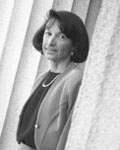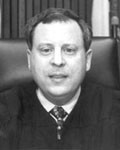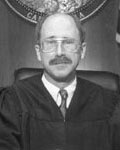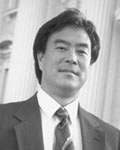Honor Guard
Ruling Class: Candidates for the two judicial seats--Barbara Spector (top left), running against Judge Gene Hyman (top right), and Judge Edward Lee (lower left) , squaring off with Steve Nakano (lower right) --have differing views on whether the current system is too incestuous for its own good.
How money, influence and tradition have molded the powerful judgeships in Santa Clara County with little input from the public
By Laura Stuchinsky
At first, only a few of the county's nearly 200 deputy district attorneys paid any attention to the notice posted on the office bulletin board.
It was summer, after all. Shifting caseloads, vacations and kids home from school posed plenty of distractions. But by the end of July, when the freshly formed "District Attorney's Association" had formulated its endorsements for the upcoming judicial races, word of the organization's activities spread as swiftly and suddenly as sparks in a dry forest.
After a spirited meeting attended by many of the county's prosecutors, the organization was dissolved, and every one of its endorsements canceled. In fact, the official statement was that the organization had never existed. The preliminary endorsements claimed by the candidates were simply a "miscommunication," as Deputy District Attorney Delores Carr later explained it.
The decision not to play politics in races for the judicial posts stands in stark contrast to what has become business as usual in Santa Clara County, where attorneys routinely put their names and money behind judicial candidates. In fact, a Metro computer analysis of Santa Clara County trial court races over the past decade has shown that most candidates for the bench solicit much of their campaign treasuries from lawyers who will later plead cases before them. Metro's analysis also revealed that:
Take the Money And Rule
'HOW WOULD YOU feel if your attorney leaned over and told you in the midst of a hearing that the attorney for the opposing side was a contributor to the judge's re-election campaign?" asks Municipal Judge Edward Lee. Lee, who is running against San Jose attorney Steve Nakano for an open seat on the Superior Court, has refused contributions from attorneys.
"In my heart of hearts I feel it's unethical to take money from someone who is going to appear before me [in court]," he says.
Lee's stance, however, is atypical of judicial candidates.
Over the 10-year period examined by Metro, lawyers were the single largest source of campaign funds for most judicial races. Only a handful of candidates, including two lawyers who lost in the March primary, Douglas Allen and Thomas Spielbauer, restricted the donations they accepted from attorneys.
At a minimum, three of the four judicial candidates heading into the November runoff--Nakano, San Jose attorney Barbara Spector and Municipal Judge Eugene Hyman--have raised between 16 percent and 36 percent of their campaign treasuries from attorneys. Those percentages reflect only contributors who donated a minimum of $100 and whose names and occupations were therefore declared by the candidates.
As of Sept. 30, lawyers donated at least $36,000 to Hyman's campaign--or 36 percent of his treasury. Spector raised at least $24,000, or 23 percent, of her war chest from attorneys. For Nakano it was $14,000 or 16 percent.
As far as the California Code of Conduct is concerned, that's perfectly fine.
"We specifically and deliberately left in the ability to raise money from attorneys," explains Constance Dove, executive director of the California Judicial Association, which wrote the ethics policy. "If you ask judges to run, you can't cut off the source of funding from the people who know them best."
"I think it's a red herring," says Nakano, whose opponent, Lee, has made attorney contributions an issue in their race. "Lawyers don't expect anything back for their contribution. They're just supporting the person they think would be the best judge."
"If you're worth your weight as a judge, you know how to make the calls without the conflict coming up," concurs Spector.
But some candidates who have relied heavily on lawyers to finance their campaigns remain uncomfortable with this arrangement.
"I don't like the fact that you're an attorney, and I'm asking you for money," Hyman says. "No matter how much I preface my words, I never feel comfortable."
Lee recalls being on the other side of the table when he was a prosecutor in the district attorney's office.
"In the back of your mind you're wondering what happens if you don't give," says Lee. "Then you wonder if you gave enough. Then you hate yourself for even asking that question."
"You always have to ask what's in it for them," concurs Municipal Court Commissioner John Triplett, a 1986 candidate for the Municipal Court. "Even if a judge is totally honest, it's got to subconsciously affect them."
In fact, Triplett, who accepted endorsements himself, now thinks judicial candidates shouldn't accept them from organizations such as police associations, whose members appear before the bench. All of the members of the current crop of judicial candidates have accepted money or endorsements from at least one special-interest group, including unions, peace officers associations and business political action groups.
More about the candidates and
Careful Arrangements
MANY JUDGES would prefer an appointment system, as is now the case in the state appellate courts, but in the trial courts elections are the law. However, Santa Clara County voters don't vote for the vast majority of their trial judges.
In the last 10 years, 85 percent to 95 percent of judges up for reelection were unopposed, and in California, the names of uncontested judges don't appear on the ballot.
In fact, because most trial lawyers tend to retire mid-term, a courtesy to the governor who appoints their replacement, most judges have been promoted to the bench without having to go before the voters at all. These are the folks who decide who gets custody of the kids in a contested divorce, whether a 15-year-old is sent to juvenile hall for selling crank at the local elementary school, or if a senior citizen can win her house back after being defrauded by an unscrupulous financial adviser.
As far as judges are concerned, that's a relief.
"Fortunately, there aren't many contested elections," sighs Muni Court Judge Lee, "I hope that means that the public is happy with the judiciary," Lee says.
That's how Dove, of the California Judges Association, also sees it.
"Elections provide a safety valve for a community that may have lost confidence in a judge," she explains. "They're also a safety valve for judges not in the governor's party to get on the bench."
In the last decade, only one seated judge was challenged in Santa Clara County--Municipal Court Judge Ed Pearce in 1986. He was re-elected.
Dove acknowledges that municipal judges "try to avoid" challenging superior judges since they work so closely together. That chummy relationship also serves as a deterrent to challengers, say insiders.
"There's a perception among the legal profession of long standing that one should not challenge seated judges," confirms San Jose attorney Esau Herrera, who ran unsuccessfully for the Municipal Court in 1992.
Court Commissioner Triplett speculates that if a challenger failed, it could create bad feelings. The lawyer would have to appear before the judge, and possibly other disgruntled colleagues.
"All you've done is create an antagonism in your own work environment," concurs Craig Holman, co-author of The Price of Justice, an oft-cited, 1995 study of judicial campaign funding in Los Angeles sponsored by the California Commission on Campaign Finance, a nonpartisan think-tank.
"I don't know how anybody can call it democratic," Holman says of judicial elections. "Voters don't even know who these people are even when they get on the ballot. There's no voter information. There's no intelligent voter information from which to make a choice."
Don't Ask, Don't Tell
'WHAT IS YOUR stand on Three Strikes?" "How about the death penalty?" "Choice?" "Affirmative action?"
Voters fired questions such at these at Municipal Court Judge Gene Hyman and his opponent for the Superior Court, San Jose attorney Barbara Spector, at a recent public forum.
"All I could say is that I'm going to follow the law," Hyman says, an answer he acknowledges understandably frustrates many voters.
California's Code of Conduct, which was drafted by the California Judges Association, restricts judges from saying anything to the voters that "commit[s] or appears to commit the candidate with respect to cases, controversies or issues that could come before the courts."
The intent of the code is to protect the independence and honor of the judiciary. But critics note the code also protects incumbents from substantive attack by challengers who are bound by the same code. It also reduces campaigns to banalities, such as "I have integrity" or "I'll be tough on crime," says James Brent, a political science professor at San Jose State University who specializes in judicial politics. A handful of other states have eased or eliminated these restrictions.
State law also prohibits judges from talking about opponents in their ballot statement or revealing their party affiliation--other potential clues about a judge's philosophy and qualifications.
"You've sort of hit a black hole," says Tat Blesch, president of the Saratoga-Los Gatos-Monte Sereno League of Women Voters, of judicial elections. "The general populace does not feel well-educated on judicial races."
Part of the problem, she says, is that the media largely ignores judicial races, which are overshadowed by more prestigious races and controversial propositions. Even the league, which sponsors educational forums on propositions, doesn't address the issue. The nonpartisan organization has historically steered clear of all individual races. However recognizing voters' plight, the league is thinking of making an exception for judicial candidates. Nothing will happen in time for this year's race, however.
In the meanwhile, the league advises voters to refrain from voting on races about which they don't feel sufficiently informed. Many voters are already following the league's advice. Half of those who cast a vote for a presidential candidate in the March primary didn't mark the judicial portion of their ballot.
Voters aren't the only ones who are frustrated.
"There's no way people can know your ability; it's just sort of a futile thing," says court commissioner Triplett. "There's not an effective way of getting your message across except the ballot statement, which is free." But, he continues, "the ballot statement can say anything short of an outright lie."
Campaign Inflation
THIS YEAR'S Superior Court race is setting new local records for the cost of running judicial campaigns. As of Sept. 30, Spector had raised $104,000. Her opponent Hyman was right behind her with $99,000. Nakano had raised $87,000, while his opponent Lee had collected about $13,000.
Given the fact that either money or the title 'Judge" before one's name are strong indicators of success in judicial elections, it's not surprising that the two attorneys who face a judge are fundraising aggressively. Over the last decade, the median raised by judicial winners was $15,000, $4,430--or 42 percent--more than the losers.
It's hard to measure what effect campaign donations, insufficient voter information, low voter participation and uncontested judicial races have had on the quality of the judiciary or its decisions. But researchers report that the public's confidence in the court system has eroded.
A 1992 survey by the California Judicial Council cited in The Price of Justice found that 52 percent of Californians had a "poor" or "only fair" opinion of the judiciary. However, judges still ranked higher than the governor, legislators and the media.
"The greatest challenge facing the judiciary is the lack of public faith in the system," Nakano says. His solution: more campaigns.
"The more that we have judges out there interacting with the public, the more the public is going to have faith that the system is working."
In Holman's thinking, public confidence in the judicial system won't be restored until the method of selecting justices is made more democratic.
"We're selecting judges not based on merit, but based on money," he says. The public "can't even vote for many of their judges. Any time there's that kind of barrier, there's no trust. There's no public accountability."
"Without accountability, the whole system is opened up for abuse, scandal and definitely a lack of public confidence," concurs Kim Alexander, director of the California Voter Foundation, a nonpartisan voter education organization. "Either we've got to make it much easier for voters to make informed choices, or we've got to reduce the number of choices and have all judges appointed."
Holman agrees. "We should either have a democratic system or appointment. This in-between [system] pleases no one."
[ Metro | Metroactive Central | Archives ]
This page was designed and created by the Boulevards team.




Photos by Christopher Gardner![[line]](/gifs/line.gif)
Propositions 208 and 212 online.![[line]](/gifs/line.gif)
From the October 24-30, 1996 issue of Metro
Copyright © 1996 Metro Publishing, Inc.
![[Metroactive News&Issues]](/gifs/news468.gif)